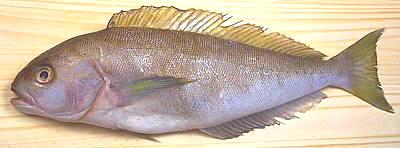 [Caulolatilus princeps]
[Caulolatilus princeps]
This East Pacific fish is found from Vancouver Island, Canada to Peru (though rare north of Central California) and can grow to over 40 inches and over 12 pounds. The photo specimen was 17-1/2 inches and 1-1/4 pounds but I have bought them up to 21 inches and 4-1/2 pounds. The FDA tilefish mercury warning does not apply to this fish, it is safe and an all around excellent eating fish.
More on the Tilefish Family.
Ocean Whitefish is an excellent eating fish with mild attractively flavored flesh that holds together well for dry cooking but flakes apart easily on the plate into large firm flakes. It can be poached, but will come apart with longer wet cooking. If used in soups, it should go in a few minutes before serving.
Buying: Ocean Whitefish is often available in Asian fish markets here in Los Angeles, though less commonly in the Philippine markets. My most recent purchase was at 2016 US $2.39 / pound at an Asian morket in Los Angles (San Gabriel). It is probably not common on the East Coast as it is a strictly Pacific fish, but the Great Northern Tilefish is, now sold as Golden Snapper or Golden Bass due to the mercury fiasco, which actually applies only to the Gulf Coast.
Scales: This fish is completely covered with smallish scales with medium adhesion, so they take only moderate energy to scrape off and don't fly around a whole lot. You may have to shave some off with the sharp edge of your knife.
Cleaning: The Whitefish is a little more difficult than some fish, because the body cavity goes well aft of the vent, and there's stuff you need to scrape out of there (not a problem if you're going to fillet the fish). There's a fair amount of tough membranes you may wish to use your long nose pliers to pull out. Use your kitchen shears to cut out the gills.
Filet: Ocean Whitefish is pretty easy to fillet with easy to follow bone structure. Start by removing the head. After cutting down to the backbone full length, hop over it at the tail and work forward until you get to the rib cage. Use kitchen sheers to cut the ribs from the backbone and pull them from the fillet. I cut the thin limp belly from the fillet and toss it in the stock pot.
There are substantial centerline pinbones from the front to well aft of the body cavity. Use your long nose pliers and pull them out straight forward. The problem is, they break easily and you have to dive deeply into the flesh to get at the strong part. They pull hard because the tips are anchored to the skin.
Skin: The skin has no strong or unpleasant flavors, so it can be used in the stock pot with the head, bones and fins. It shrinks very strongly when heated, and will curl a fillet severely if left on, even for frying. The skin adheres tightly, but is much stronger than the flesh, so it is easily removed using the long knife and cutting board Method.
Yield: This is a meaty fish so yield is quite good. A 2-1/4 pound fish yielded 1-1/4 pounds of skinless fillet (56%) and a 4-1/2 pound fish yielded 2 pounds 4-1/8 ounces (50%).
Stock: The head, fins and bones and skin, simmered for 40 minutes, make an excellent cleanly flavored stock with little oil - but remove what there is using your gravy separator. For details see our Making Fish Stock page.
sf_tileowz 061028 r 081103 - www.clovegarden.com